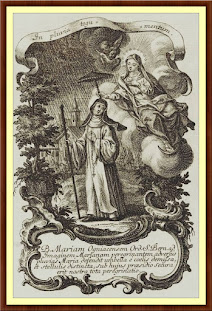Early Life: Blessed Mary of Oignies was born in Nivelles, Brabant (present-day Belgium), around 1177. She came from a wealthy and pious family, which provided her with a strong foundation in the Christian faith. From a young age, Mary exhibited a deep devotion to God and a desire to live a life of piety and service.
Marriage and Early Devotion: Despite her inclination towards a religious life, Mary was married at a young age to a man named John. Remarkably, she persuaded her husband to take a vow of celibacy with her, and together they committed themselves to a life of charity and spiritual discipline. They dedicated their wealth and resources to helping the poor and the sick.
Life of Asceticism: Around 1207, Mary and John decided to live separately to pursue a more intense ascetic life. Mary moved to a hermitage near the leper hospital of Willambroux, near Nivelles, where she cared for the sick and the poor. Her life was characterized by severe austerity, including long periods of fasting and prayer. She wore a hairshirt and engaged in practices of self-mortification as a means of deepening her spiritual discipline.
Community at Oignies: Mary's piety and charity attracted followers, and she eventually moved to Oignies, near Namur, where she joined a community of Beguines. The Beguines were women who lived religious lives without taking formal vows. At Oignies, Mary continued her life of prayer, charity, and penance. Her reputation for holiness spread, and she became known for her mystical experiences and spiritual insights.
Spiritual Influence and Mysticism: Mary of Oignies was renowned for her mystical experiences, which included visions and ecstatic states. She experienced profound moments of union with God, often accompanied by physical manifestations such as tears of blood. These mystical experiences, along with her deep compassion and humility, made her a respected spiritual figure.
Relationship with James of Vitry: Mary's spiritual influence extended to notable religious figures of her time. One of her most significant relationships was with James of Vitry, a cleric who later became a bishop and cardinal. James was deeply influenced by Mary's spirituality and wrote her biography, "The Life of Mary of Oignies," which became an important document in the history of Christian mysticism and the Beguine movement.
Death and Beatification: Blessed Mary of Oignies died on June 23, 1213. Her death marked the end of a life devoted to God and service to others. Despite not being formally canonized, she was beatified, and her feast day is celebrated on June 23. Her life and virtues were recognized and celebrated within the Christian community, particularly among the Beguines and those devoted to mystical spirituality.
Legacy: Blessed Mary of Oignies is remembered for her profound piety, her dedication to the poor and the sick, and her mystical experiences. Her life served as an inspiration to the Beguine movement and to those seeking a deeper, more personal connection with God. Her influence continued through the writings of James of Vitry and the many followers who were inspired by her example.
Mary of Oignies' legacy is a testament to the power of faith, charity, and the pursuit of spiritual depth. Her life continues to inspire those who seek to live a life of devotion and service, and her contributions to Christian mysticism remain significant in the history of the church.
.









%20Virgin%20and%20Martyr.jpeg)